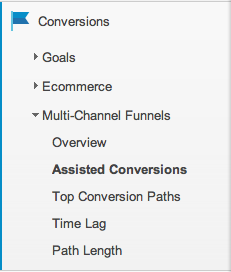
Get your FREE 30-day trial.
Please complete all fields.
If you are having trouble measuring social media lead generation, you're not alone.
For most businesses, there are an infinite number of paths to conversion. Most analytics tools attribute a conversion to the last interaction. In other words, unless social media was the "last touch" before the conversion, it won't get credit. Analytics professionals refer to this as a problem of attribution.
 It's clear that Google understands that marketers are concerned with attribution. Google Analytics has added a number of reports that can determine whether social media is leading to conversions. These reports are located under Conversions > Multi-Channel Funnels inside Google Analytics.
It's clear that Google understands that marketers are concerned with attribution. Google Analytics has added a number of reports that can determine whether social media is leading to conversions. These reports are located under Conversions > Multi-Channel Funnels inside Google Analytics.
Note that in order to use any of the Conversion reports in Google Analytics you will need to have goals set up. For more information on setting up goals in Google Analytics, read this tutorial from Google.
If you have goals set up, you are now ready to use Multi-Channel Funnel reports in Google Analytics. One of the most useful Multi-Channel Funnel reports is the Assisted Conversions Report.
What is the Assisted Conversions Report?
The Assisted Conversions report allows you to determine the direct and indirect impact of a digital marketing channel on a conversion goal. A direct impact is attributed to a marketing channel when it is the last interaction before the conversion. All other interactions along the path to conversion have an indirect impact.
For example, a company that has set a conversion goal within Google Analytics that triggers after a site visitor fills out a form might have a conversion path that looks like this:
Social Media > SEO > PPC > Conversion
In a last interaction model, PPC would receive 100% of the credit. But the Assisted Conversions report in Google Analytics will assign an assisted conversion to SEO and Social Media.
The Assisted Conversions reports a raw number of assisted conversion along with the ratio of direct (last interaction) against assisted conversions. A higher ratio indicates that the channel is more likely to be assisting conversion while a lower ratio number indicates that the channel is often the last interaction before conversion.
In the following scenario you can see that Twitter provides more assisted conversions than Bing which has a more direct impact. The last numbers on the right are the assisted conversion ratios.

With a .91 Assisted Conversions ratio for Twitter and a .40 ratio for Bing, it is clear that Twitter is often a catalyst for future conversions.
Of course, these numbers mean nothing unless you take action on them. Analytics are meant to guide the business decisions you make. For example, perhaps this report would help you determine if Twitter is a viable channel for your business.
The Assisted Conversions report and other Multi-Channel funnel reports allow us to see how different marketing channels are contributing to the conversion path.
Map out your paths, set up your analytics reports, measure the data, and then most importantly, act upon it.